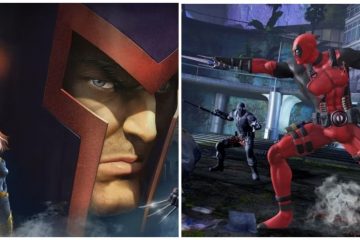Swinging from the silver screen to the page, the Spider-Man: Across the Spider-Verse breakout antagonist returns in Miguel O’Hara: Spider-Man 2099 #1. Written by Steve Orlando, reprising his role after penning Spider-Man 2099: Exodus (2022) and Spider-Man 2099: Dark Genesis (2023), illustrated by Devmalya Pramanik, with colors by Raúl Angulo and letters by VC’s Cory Petit. With the explicit aim of further building out the 2099-Universe, this limited five-part run pits Miguel O’Hara against a host of classic horror villains and revisits and introduces the 2099 counterparts to iconic Marvel heroes.Miguel O’Hara: Spider-Man 2099 #1 opens one year ago, on a grisly zombie attack in a cemetery in Nueva York, with only a single survivor. In the present day, Miguel O’Hara takes an evening out from being Spider-Man to reconnect with his mother — only to discover that she is infected with a zombie virus. With the help of Blade 2099, Spider-Man must try to find an antidote before the Barrio is overrun entirely.Miguel O’Hara: Spider-Man 2099 #1 has an interesting and powerfully idiosyncratic art style, with Pramanik working in heavy lines with dense inking to create a distinctly neon-noir tone. Laden with shadows and intense use of hatching and shading, Pramanik builds a highly textured, almost impressionistic style that has powerful neo-gothic overtones, amplifying the comic’s horror influences and creating some remarkably chilling tableaus. Making the most of drawing out small details and varying textures within a single panel, many moments have an impressive viscerality that elevates their emotional and visual impact. Despite the surreal style that occasionally overtakes the comic, the sense of figures and anatomy are consistent, and the character’s expressions have a strikingly emotive quality. Pramanik does very well to infuse their characters with a sense of animacy, often using shading to carve out lots of dimension to the faces for maximum visual drama. The action sequences of Miguel O’Hara: Spider-Man 2099 #1 are fantastic, keying into Spider-Man’s dynamic combat style to create fight scenes that brim with fluid force and momentum. This is aided massively by the creative and internally engaged panel design, which often uses unconventional shapes to draw the eye down the page and complement the flow of movement. There are also plenty of excellent blurring effects throughout the comic, creating the impression of abrupt flurries of motion that perfectly punctuate intense moments.
Swinging from the silver screen to the page, the Spider-Man: Across the Spider-Verse breakout antagonist returns in Miguel O’Hara: Spider-Man 2099 #1. Written by Steve Orlando, reprising his role after penning Spider-Man 2099: Exodus (2022) and Spider-Man 2099: Dark Genesis (2023), illustrated by Devmalya Pramanik, with colors by Raúl Angulo and letters by VC’s Cory Petit. With the explicit aim of further building out the 2099-Universe, this limited five-part run pits Miguel O’Hara against a host of classic horror villains and revisits and introduces the 2099 counterparts to iconic Marvel heroes.
Miguel O’Hara: Spider-Man 2099 #1 opens one year ago, on a grisly zombie attack in a cemetery in Nueva York, with only a single survivor. In the present day, Miguel O’Hara takes an evening out from being Spider-Man to reconnect with his mother — only to discover that she is infected with a zombie virus. With the help of Blade 2099, Spider-Man must try to find an antidote before the Barrio is overrun entirely.
Miguel O’Hara: Spider-Man 2099 #1 has an interesting and powerfully idiosyncratic art style, with Pramanik working in heavy lines with dense inking to create a distinctly neon-noir tone. Laden with shadows and intense use of hatching and shading, Pramanik builds a highly textured, almost impressionistic style that has powerful neo-gothic overtones, amplifying the comic’s horror influences and creating some remarkably chilling tableaus. Making the most of drawing out small details and varying textures within a single panel, many moments have an impressive viscerality that elevates their emotional and visual impact. Despite the surreal style that occasionally overtakes the comic, the sense of figures and anatomy are consistent, and the character’s expressions have a strikingly emotive quality. Pramanik does very well to infuse their characters with a sense of animacy, often using shading to carve out lots of dimension to the faces for maximum visual drama. The action sequences of Miguel O’Hara: Spider-Man 2099 #1 are fantastic, keying into Spider-Man’s dynamic combat style to create fight scenes that brim with fluid force and momentum. This is aided massively by the creative and internally engaged panel design, which often uses unconventional shapes to draw the eye down the page and complement the flow of movement. There are also plenty of excellent blurring effects throughout the comic, creating the impression of abrupt flurries of motion that perfectly punctuate intense moments.
#REVIEW #Marvels #Miguel #OHara #SpiderMan
Note:- (Not all news on the site expresses the point of view of the site, but we transmit this news automatically and translate it through programmatic technology on the site and not from a human editor. The content is auto-generated from a syndicated feed.))



